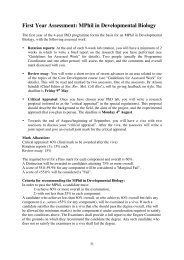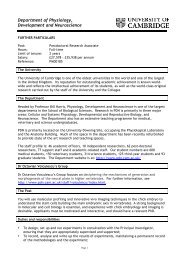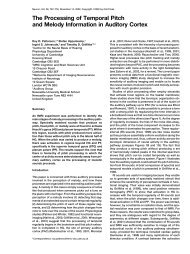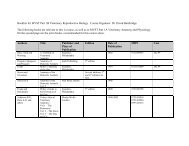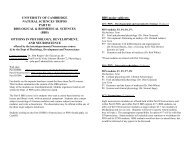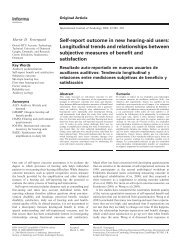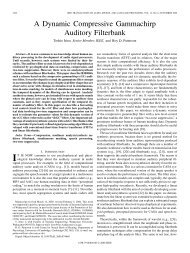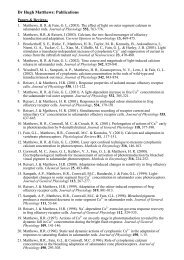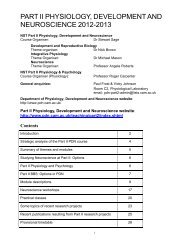FRIDAY MORNING, 20 MAY 2005 REGENCY E, 8:30 A.M. TO 12:00 ...
FRIDAY MORNING, 20 MAY 2005 REGENCY E, 8:30 A.M. TO 12:00 ...
FRIDAY MORNING, 20 MAY 2005 REGENCY E, 8:30 A.M. TO 12:00 ...
Create successful ePaper yourself
Turn your PDF publications into a flip-book with our unique Google optimized e-Paper software.
ducer placement scoring process, involving Hankel singular values<br />
HSVs, is combined with a genetic optimization routine to find spatial<br />
locations robust to boundary condition variation. Predicted frequency response<br />
characteristics are examined, and optimized results are discussed in<br />
relation to boundary condition variations. Results indicate it is possible to<br />
minimize the impact of uncertain boundary conditions in active structural<br />
acoustic control by optimizing the placement of transducers with respect<br />
to uncertainties. Both analytical and experimental results will be discussed.<br />
10:<strong>00</strong>–10:15 Break<br />
energy sinks do not require presence of damping in the classical sense. A<br />
set of undamped oscillators that make up an energy sink collectively absorb<br />
the vibratory energy and retain it in their phase space. Earlier optimization<br />
studies by the authors have shown the feasibility of vibration<br />
absorption and retention by energy sinks if the set of oscillators have a<br />
particular frequency distribution. Experimental results support the concept<br />
of energy sinks. Different physical realizations of energy sinks demonstrate<br />
the significance of frequency distributions and the ability of energy<br />
sinks to reduce vibration amplitude of a primary structure to which they<br />
are attached.<br />
10:15<br />
5aSA5. Optimal energy dissipation in a semi-active friction device.<br />
Paulin Buaka, Philippe Micheau, and Patrice Masson GAUS, Mech.<br />
Eng. Dept., Université de Sherbrooke, Sherbrooke, QC, Canada J1K 2R1,<br />
Patrice.Masson@USherbrooke.ca<br />
A semi-active device is presented for vibration control using energy<br />
dissipation by dry friction at contact surfaces. Semi-active behavior is<br />
provided by two piezoelectric stack actuators driven in real time to apply<br />
a normal force on a mobile component through two friction pads. Theoretical<br />
and experimental results show that there is an optimal constant<br />
normal force to maximize the energy dissipated for the case of a harmonic<br />
disturbance. In order to improve the energy dissipation by real time control<br />
of the normal force, two nonlinear controllers are proposed: 1 the<br />
Lyapunov method leading to a nonlinear bang-bang controller law and 2<br />
the feedback linearization approach leading to equivalent viscous friction.<br />
The implementation of both strategies is presented and both are experimentally<br />
assessed using a clamped-free beam with the semi-active device<br />
attached to the beam. It is shown that a proper choice for the parameters of<br />
the controllers leads to an increased energy dissipation with respect to the<br />
case where the normal force is constant. This dissipation is further increased<br />
by adjusting a phase shift in the nonlinear feedback loop in order<br />
to avoid a stick-slip motion of the mobile component.<br />
10:<strong>30</strong><br />
5aSA6. Energy sinks: Vibration absorption by an optimal set of<br />
undamped oscillators. Ilker Koç Mech. Eng. Dept., Carnegie Mellon<br />
Univ., Pittsburgh, PA 15213, Antonio Carcaterra Universita Degli Studi<br />
di Roma ‘‘La Sapienza,’’ <strong>00</strong>184 Roma, Italy, Zhaoshun Xu, and Adnan<br />
Akay Carnegie Mellon Univ., Pittsburgh, PA 15213<br />
This presentation offers the concept of energy sinks as an alternative to<br />
conventional methods of vibration absorption and damping. A prototypical<br />
energy sink envisioned here consists of a set of oscillators attached to, or<br />
an integral part of, a vibrating structure. The oscillators that make up an<br />
energy sink absorb vibratory energy from a structure and retain it in their<br />
phase-space. In principle, energy sinks do not dissipate vibratory energy as<br />
heat in the classical sense. The absorbed energy remains in an energy sink<br />
permanently so that the flow of energy from the primary structure appears<br />
to it as damping. This paper demonstrates that a set of linear oscillators<br />
can collectively absorb and retain vibratory energy with near irreversibility<br />
when they have a particular distribution of natural frequencies. The approach<br />
to obtain such a frequency response is based on an optimization<br />
that minimizes the energy retained by the structure as a function of frequency<br />
distribution of the oscillators in the set.<br />
10:45<br />
5aSA7. Experiments on vibration absorption using energy sinks.<br />
Adnan Akay, Zhaoshun Xu Mech. Eng. Dept., Carnegie Mellon Univ.,<br />
Pittsburgh, PA 15213, Antonio Carcaterra Universita Degli Studi di<br />
Roma ‘‘La Sapienza,’’ <strong>00</strong>184 Roma, Italy, and Ilker Koç Carnegie<br />
Mellon Univ., Pittsburgh, PA 15213<br />
This presentation describes experiments that demonstrate the concept<br />
of energy sinks where a set of multiple undamped linear oscillators attached<br />
to a vibrating structure can absorb most of its energy. In principle,<br />
11:<strong>00</strong><br />
5aSA8. Experimental study on passiveÕactive hybrid isolation. Zi Jun<br />
Zhang, Woo Suk Chang, Koon Meng Nyang, and Yew Wing Chan DSO<br />
Natl. Labs., Singapore. No <strong>20</strong>, Sci. Park Dr., Singapore 1182<strong>30</strong><br />
This paper discusses the control of a high stroke low stiffness nonlinear<br />
actuator which formed the key element of a smart engine mount<br />
system that provides strong support for the engine while at the same time<br />
absorbing the engine vibration energy. The actuator is made of a stacked<br />
PZT embedded in an elliptical shaped metal frame, in the horizontal direction.<br />
Due to the geometry of the frame, the displacement generated by<br />
the PZT stacks is amplified up to about 5 times in the vertical direction.<br />
However, due to the geometry of the actuator, the vertical and horizontal<br />
motions are non-linear and excite motions at multiples of the driving frequency.<br />
Feedback controllers cannot be used since the high frequency<br />
motion causes spillover problem and control becomes unstable. The<br />
filtered-X adaptive controller with sufficient high sampling rate is tested<br />
and found to be a useful and reliable controller for the actuator for suppressing<br />
the vibration to almost ambient noise level. This actuator requires<br />
relatively lower driving voltage level and delivers larger stroke range. This<br />
would be more suitable for vibration isolation application where the actuator<br />
is serially connected with passive dampers.<br />
11:15<br />
5aSA9. Comparison between control strategies for active constrained<br />
layer damping treatment to control the sound radiation from a<br />
vibrating structure. Hui Zheng, Chun Lu, and Heow Pueh Lee Inst. of<br />
High Performance Computing, 1 Sci. Park Rd., #01-01 The Capricorn, Sci.<br />
Park II, Singapore 117528<br />
A comparative study is presented of three control strategies for active<br />
constrained layer damping ACLD treatments to control the sound radiation<br />
from a vibrating planar structure. The first control strategy is one<br />
commonly used in most existing studies of ACLD for structural vibration<br />
control; i.e., the error signal to be minimized for the controller is the<br />
vibration response sensed by point transducers, and a proportional derivative<br />
controller is employed where the sensor signal and the voltage output<br />
is related by real-valued feedback gains. The second control strategy is<br />
similar to the first, except that the real-valued control gains are substituted<br />
by complex-valued ones. In the third control strategy, the discrete structural<br />
acoustic sensing approach is introduced for observing the sound radiation<br />
from the structure, and the estimated sound power constitutes the<br />
controller input. The control gains aiming to reduce the sound radiation<br />
from a simply-supported beam are optimized respectively for the three<br />
control strategies, and the control performances are compared. Numerical<br />
results show that using the complex-valued control gain in the controller<br />
design is always better than using real-valued gain. Furthermore, the<br />
ACLD treatments adopting the third control strategy require lowest control<br />
efforts.<br />
2602 J. Acoust. Soc. Am., Vol. 117, No. 4, Pt. 2, April <strong>20</strong>05 149th Meeting: Acoustical Society of America 2602



